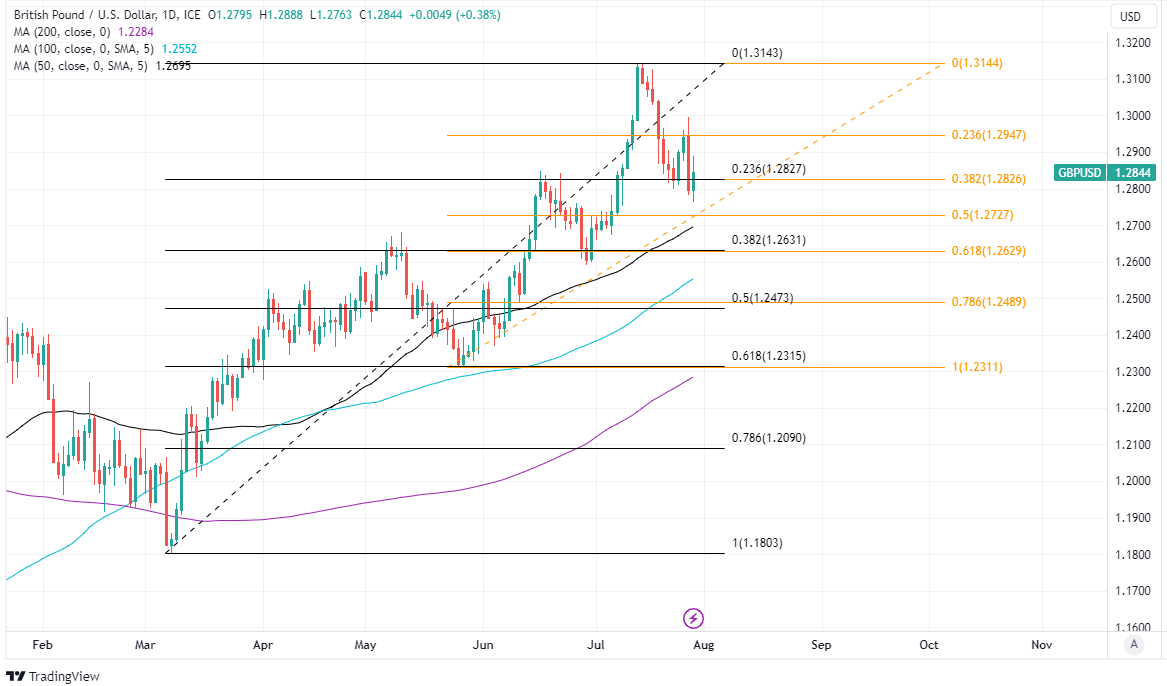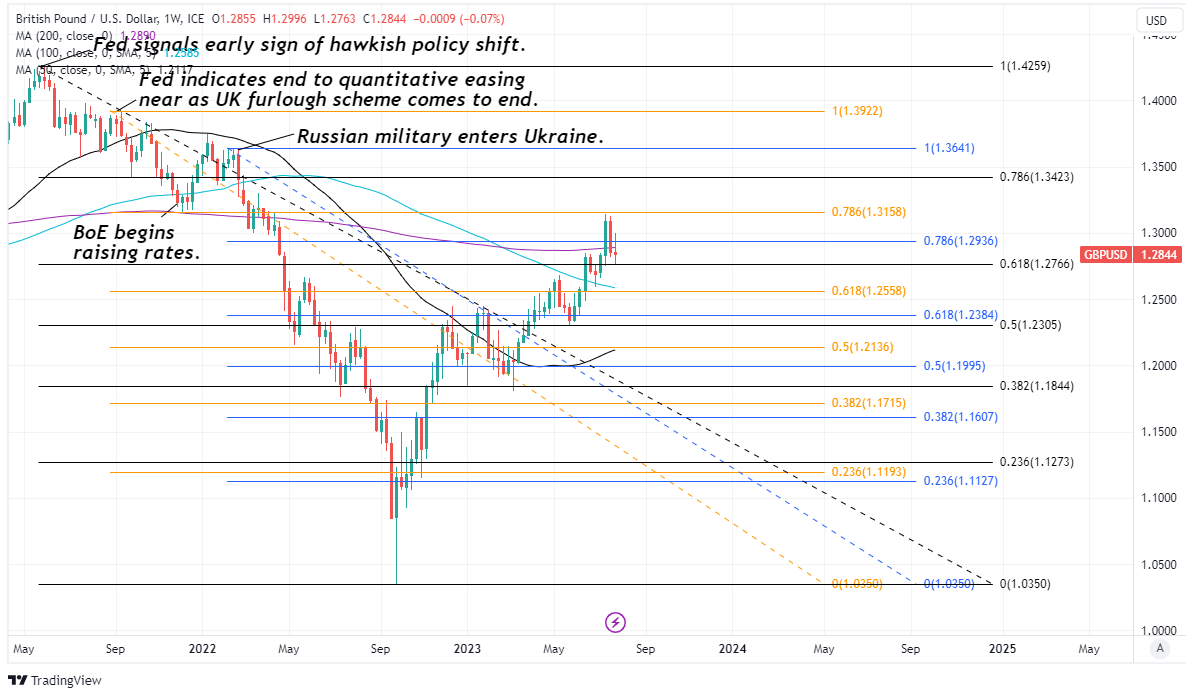GBP/USD Week Ahead Forecast: Balanced Risks from 1.2850
- Written by: James Skinner
-
- Rough & wide 1.2695 to 1.2995 range possible ahead
- Two technical supports around 1.27 underpin on chart
- Minor resistance likely on any contact with 1.30 level
- U.S. PMIs & payrolls eyed as BoE headlines for GBP

Image © Adobe Images
The Pound to Dollar exchange rate enters a formative period for the outlook and a big week for economies on both sides of the Atlantic with the potential to see highs near 1.30 and lows around 1.27 but with much of the action likely in the latter half when the Bank of England (BoE) and July non-farm payrolls report take center stage.
A strong real-terms increase in Japanese retail sales for June and better-than-expected reading of the China Federation of Logistics and Purchasing (CFLP), Purchasing Managers' manufacturing PMI pushed the Dollar onto its back foot while helping lift other currencies including Sterling ahead of the European open on Monday.
Rising Asia Pacific currencies saw the Dollar remain under strain while helping the Pound retain a foothold above 1.28 following a Friday recovery of the level and going into an action-packed period for economic data, government bond markets and Bank of England policymakers at the opening of the new week.
“The pullback in GBPUSD has been contained as expected by its uptrend from September last year, now seen at 1.2775 and we similarly view this as a corrective and temporary decline only ahead of a break above the 1.3143 recent high for resistance next at 1.3299,” says David Sneddon, a managing director at Credit Suisse.
“A fall below the uptrend from last September and recent low at 1.2797/75 would suggest instead a more concerted pullback/consolidation with support seen next at 1.2672, but with the 1.2590 late June low ideally holding,” he writes in a technical analysis presentation last Thursday.
Above: Pound to Dollar rate shown at daily intervals with selected moving averages and Fibonacci retracements of recent uptrends indicating possible areas of technical support for Sterling.
Risk comes thick and fast from the get-go for Sterling this week with money and credit numbers from the Bank of England out on Monday before being followed by a 02-year bond auction on Tuesday, an interest rate decision on Thursday and a speech from the BoE’s chief economist Friday.
But in amongst all of this, the Pound-Dollar rate must also navigate a busy U.S. economic calendar including a fresh set of Institute for Supply Management surveys of the manufacturing and services sectors on Tuesday and Thursday, as well as three different measures of labour market health on Tuesday, Wednesday and Friday.
“There is a clear skew to the downside here, suggesting a stronger GBP is unlikely at this stage. Adding to this sense of over-exuberance for GBP are broader valuations,” says Dominic Bunning, European head of FX research at HSBC.
“Valuation misalignments often persist, but when taken alongside positioning data, and signs of softening UK activity and inflation, they suggest further upside for GBP will be harder to come by without idiosyncratic economic outperformance,” he writes in a research briefing last Thursday.
Bunning and the HSBC team say “we are not outright bearish on GBP-USD” having noted signs of Dollar “overvaluation” and recently tipped Sterling as a buy relative to the Norwegian Krone but have warned of downside risk in the short-term connected with recently significant speculative interest in the Pound.
Above: Quantitative model estimates of ranges for the week ahead. Source Pound Sterling Live.
Others also see relatively balanced risk for Sterling in the short-term with much hinged on the outcome of Thursday’s Bank of England (BoE) interest rate decision where the consensus among economists suggests an increase in Bank Rate from 5% to 5.25% and market pricing implies some risk of a larger move.
“If a 50bp hike is delivered then GBP/USD can head higher towards upside resistance at 1.3142 (100% Fibbo). Financial markets are currently pricing only a small chance of a 50bp hike,” says Kristina Clifton, a senior economist and currency strategist at Commonwealth Bank of Australia.
Thursday’s forecast update from the Bank of England will be every bit as important as the interest rate decision in determining the prospects of the Pound up ahead, and particularly in the face of implied financial market expectations for three further increases to take Bank Rate from 5% to 5.75% by year-end.
“They’ve got a number of further increases priced in for us. My response to that would be: Well, we’ll see,” Governor Andrew Bailey said at a European Central Bank (ECB) conference in June and at a point when interest rate swap markets were suggesting a peak in Bank Rate of almost 6.5%.
Inflation has fallen since then and kept alive hope as well as scope for something like the May forecasts still being met with inflation falling to around 7% in July and something like 4% by year-end but based on a Bank Rate no higher than 4.75% by year-end.
Above: Pound to Dollar rate shown at weekly intervals with Fibonacci retracements of selected downtrends indicating possible areas of technical resistance for Sterling. Selected moving averages denote possible support and/or resistances.
“Funny things happen in the markets all the time. A case in point is the news over the weekend that the Bank of England will be leaning on the expertise of Ben “sub-prime is contained” Bernanke to lead a review into the Bank’s forecasting performance,” says Benjamin Picton, a macro strategist at Rabobank.
“We’re not suggesting that a bit of navel-gazing wouldn’t be justified for the Bank given its recent forecasting performance,” he adds in a Monday market commentary [With all due respect to the incoming Dr Bernanke, Pound Sterling Live readers are either informed or reminded that the BoE has one of the better track records, if not the best track record in inflation forecasting and inflation targeting when compared with other advanced economy central banks, though its forecasts have been off the mark in more recent years].
Either side of the Thursday decision, however, surveys of key U.S. industries and measures of labour market momentum will be in focus following a flurry of better-than-expected economic numbers out last week including stronger growth for last quarter and further declines in the preferred inflation measure of the Federal Reserve.
“The bigger news, however, was that PCE core services ex-housing—the Fed’s current fixation—rose by just 0.22%, after a 0.23% increase in May, much slower than the 0.34% average for the previous three months,” says Ian Shepherdson, chief economist at Pantheon Macroeconomics.
“A sustained rollover in core PCE services ex-housing is a necessary, though not sufficient, condition for the Fed to stop hiking rates. The main risk here is a sudden jump in healthcare services inflation, lagging last year’s explosion in wage growth,” he adds.








